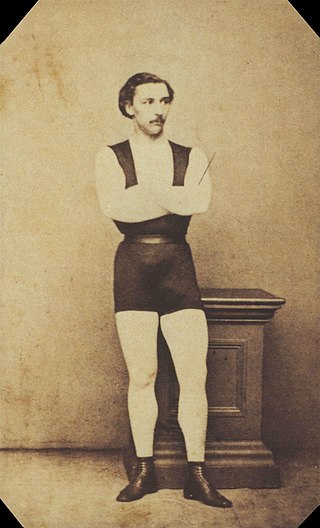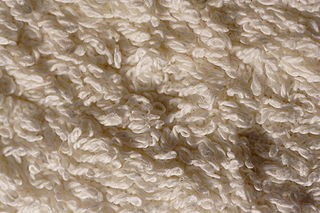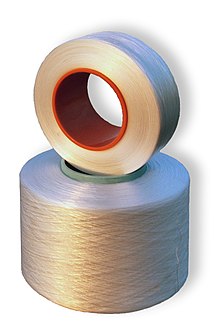
Nylon is a family of synthetic polymers with amide backbones, usually linking aliphatic or semi-aromatic groups.

Textile is an umbrella term that includes various fiber-based materials, including fibers, yarns, filaments, threads, different fabric types, etc. At first, the word "textiles" only referred to woven fabrics. However, weaving is not the only manufacturing method, and many other methods were later developed to form textile structures based on their intended use. Knitting and non-woven are other popular types of fabric manufacturing. In the contemporary world, textiles satisfy the material needs for versatile applications, from simple daily clothing to bulletproof jackets, spacesuits, and doctor's gowns.

Fiber or fibre is a natural or artificial substance that is significantly longer than it is wide. Fibers are often used in the manufacture of other materials. The strongest engineering materials often incorporate fibers, for example carbon fiber and ultra-high-molecular-weight polyethylene.

A leotard is a unisex skin-tight one-piece garment that covers the torso from the crotch to the shoulder. The garment was made famous by the French acrobatic performer Jules Léotard (1838–1870). There are sleeveless, short-sleeved, and long-sleeved leotards. A variation is the unitard, which also covers the legs. It provides a degree of modesty and style, while allowing for freedom of movement.

A skin-tight garment is a garment that is held to the skin usually by elastic tension using some type of stretch fabric. Commercial stretch fabrics ('elastomerics') such as spandex or elastane came onto the market in 1962, and revolutionized many areas of the clothing industry. A wide variety of clothing may be made to be skin-tight, and it is common for clothing to be skin-tight for some uses, such as in stockings, bodystockings, swimsuits and women's bras.
Synthetic fibers or synthetic fibres are fibers made by humans through chemical synthesis, as opposed to natural fibers that are directly derived from living organisms, such as plants or fur from animals. They are the result of extensive research by scientists to replicate naturally occurring animal and plant fibers. In general, synthetic fibers are created by extruding fiber-forming materials through spinnerets, forming a fiber. These are called synthetic or artificial fibers. The word polymer comes from a Greek prefix "poly" which means "many" and suffix "mer" which means "single units"..
Aramid fibers, short for aromatic polyamide, are a class of heat-resistant and strong synthetic fibers. They are used in aerospace and military applications, for ballistic-rated body armor fabric and ballistic composites, in marine cordage, marine hull reinforcement, as an asbestos substitute, and in various lightweight consumer items ranging from phone cases to tennis rackets.

A raincoat is a waterproof or water-resistant garment worn on the upper body to shield the wearer from rain. The term rain jacket is sometimes used to refer to raincoats with long sleeves that are waist-length. A rain jacket may be combined with a pair of rain pants to make a rainsuit. Rain clothing may also be in one piece, like a boilersuit. Raincoats, like rain ponchos, offer the wearer hands-free protection from the rain and elements; unlike the umbrella.
Twaron is a para-aramid. It is a heat-resistant and strong synthetic fibre developed in the early 1970s by the Dutch company Akzo Nobel's division Enka BV, later Akzo Industrial Fibers. The research name of the para-aramid fibre was originally Fiber X, but it was soon called Arenka. Although the Dutch para-aramid fiber was developed only a little later than DuPont's Kevlar, the introduction of Twaron as a commercial product came much later than Kevlar due to financial problems at the Akzo company in the 1970s.
Coolmax is the brand name for a series of polyester fabrics developed and marketed by The Lycra Company.

Acrylic fibers are synthetic fibers made from a polymer (polyacrylonitrile) with an average molecular weight of ~100,000, about 1900 monomer units. For a fiber to be called "acrylic" in the US, the polymer must contain at least 85% acrylonitrile monomer. Typical comonomers are vinyl acetate or methyl acrylate. DuPont created the first acrylic fibers in 1941 and trademarked them under the name Orlon. It was first developed in the mid-1940s but was not produced in large quantities until the 1950s. Strong and warm, acrylic fiber is often used for sweaters and tracksuits and as linings for boots and gloves, as well as in furnishing fabrics and carpets. It is manufactured as a filament, then cut into short staple lengths similar to wool hairs, and spun into yarn.
Invista is a fiber, resin, and intermediates company headquartered in Wichita, Kansas, United States. It has about 10,000 employees in over 20 countries worldwide. The predecessor DuPont Textiles and Interiors was formed from DuPont's textile fibers division in February 2003. The company was given the trademarked name INVISTA and was then sold to privately owned Koch Industries on April 30, 2004 for US$4.2 billion. Koch Industries combined the newly acquired organization with their KoSa subsidiary to complete the INVISTA company.

Cordura is a collection of synthetic fiber-based fabric technologies used in a wide array of products including luggage, backpacks, trousers, military wear and performance apparel.

Stretch fabric is a synthetic fabric that stretches. Stretch fabrics are either 2-way stretch or 4-way stretch.

Terrycloth, terry cloth, terry cotton, terry toweling, terry, terry towel, Turkish toweling (formerly), or simply toweling is a fabric woven with many protruding loops of thread which can absorb large amounts of water. It can be manufactured by weaving or knitting. Terrycloth is woven on special looms that have two beams of longitudinal warp through which the filler or weft is fired laterally.

Joseph Clois Shivers Jr. was an American textile chemist who was based in West Chester, Pennsylvania, best known for his role in the structural development of Spandex, a thermoplastic elastomer, in the 1950s, while employed at DuPont.

Polytetrahydrofuran, also called poly(tetramethylene ether) glycol or poly(tetramethylene oxide), is a collection of chemical compounds with formula HO(CH2)4O(CH2)4)nOH or HO((CH2)4O-)n-H. The material is a mixture of polyether diols terminated with alcohol groups. It is produced by polymerization of tetrahydrofuran as well as 1,4-butanediol.
Many materials have been used to make garments throughout history. Grasses, furs and much more complex and exotic materials have been used. Cultures like the Arctic Circle, make their wardrobes out of prepared and decorated furs and skins.[1] Different cultures have added cloth to leather and skins as a way to replace real leather. A wide range of fibers, including natural, cellulose, and synthetic fibers, can be used to weave or knit cloth. From natural fibers like cotton and silk to synthetic ones like polyester and nylon, most certainly reflects culture.
Disco pants are a type of pants or trousers created in the style of denim jeans and originally made from a combination of nylon and spandex designed to be completely form-fitting with a high shine and high waist.
Anidex is one of the elastomeric synthetic fibers. It is made from an artificial linear polymer consisting of at least 50% by mass of one or more monohydric alcohol esters.

















